Podcast
Questions and Answers
Which model is known for its simplicity and visualization of energy levels?
Which model is known for its simplicity and visualization of energy levels?
- Spherical orbits model
- Bohr model (correct)
- Modern atomic model
- Quantum-mechanical model
Which branch of physics deals with matter and energy at atomic and subatomic levels?
Which branch of physics deals with matter and energy at atomic and subatomic levels?
- Thermodynamics
- Classical Mechanics
- Quantum Mechanics (correct)
- Astrophysics
What are the three subatomic particles within an atom?
What are the three subatomic particles within an atom?
- Positrons, Electromagnetic Waves, Neutrons
- Protons, Electrons, Neutrons (correct)
- Protons, Neutrinos, Electrons
- Ions, Electrons, Neutrons
What charge does a Cation have?
What charge does a Cation have?
Which property uniquely identifies each element and is equal to the number of protons in its nucleus?
Which property uniquely identifies each element and is equal to the number of protons in its nucleus?
What is the formula to calculate the number of neutrons in an atom?
What is the formula to calculate the number of neutrons in an atom?
What do Anions represent?
What do Anions represent?
Which particle interacts with other atoms to form chemical bonds?
Which particle interacts with other atoms to form chemical bonds?
What is the symbol for an atom with an excess of 4 electrons?
What is the symbol for an atom with an excess of 4 electrons?
What is the main difference between the Bohr model and the quantum-mechanical model in predicting electron location?
What is the main difference between the Bohr model and the quantum-mechanical model in predicting electron location?
Who first used the word 'atomos' to describe indivisible particles of matter?
Who first used the word 'atomos' to describe indivisible particles of matter?
According to Dalton's atomic theory, atoms of the same element are:
According to Dalton's atomic theory, atoms of the same element are:
In the Plum Pudding Model, the atom is described as:
In the Plum Pudding Model, the atom is described as:
The Saturnian Model of the atom was proposed by:
The Saturnian Model of the atom was proposed by:
What experiment provided evidence for the existence of a compact nucleus in the atom?
What experiment provided evidence for the existence of a compact nucleus in the atom?
According to the Nuclear Model of the atom, which of the following statements is true?
According to the Nuclear Model of the atom, which of the following statements is true?
Which experiment demonstrated the energy levels of electrons in atoms?
Which experiment demonstrated the energy levels of electrons in atoms?
Which model of the atom described electrons orbiting the nucleus like the rings of Saturn?
Which model of the atom described electrons orbiting the nucleus like the rings of Saturn?
Who discovered the electron, which inspired the development of the Plum Pudding Model?
Who discovered the electron, which inspired the development of the Plum Pudding Model?
Which scientist's work established that electrons move in distinct, spherical orbits with specific energy levels?
Which scientist's work established that electrons move in distinct, spherical orbits with specific energy levels?
What is the average mass of carbon if it were 100% carbon-13?
What is the average mass of carbon if it were 100% carbon-13?
If carbon were a 50/50 mix of carbon-12 and carbon-13, what would be its average mass?
If carbon were a 50/50 mix of carbon-12 and carbon-13, what would be its average mass?
What is the actual percentage of carbon-12 in naturally occurring carbon?
What is the actual percentage of carbon-12 in naturally occurring carbon?
What is the weighted average atomic mass of lithium, given its abundances are 92.4% lithium-7 and 7.6% lithium-6?
What is the weighted average atomic mass of lithium, given its abundances are 92.4% lithium-7 and 7.6% lithium-6?
Which isotope of bromine is more common?
Which isotope of bromine is more common?
What is the weighted average atomic mass of chlorine, given its abundances are 75.8% chlorine-35 and 24.2% chlorine-37?
What is the weighted average atomic mass of chlorine, given its abundances are 75.8% chlorine-35 and 24.2% chlorine-37?
If carbon had a 75% abundance of carbon-12 and a 25% abundance of carbon-13, what would be its average mass?
If carbon had a 75% abundance of carbon-12 and a 25% abundance of carbon-13, what would be its average mass?
What is the atomic mass of carbon listed on the periodic table?
What is the atomic mass of carbon listed on the periodic table?
If bromine had an atomic mass of 80 u, which isotope of bromine would be more abundant?
If bromine had an atomic mass of 80 u, which isotope of bromine would be more abundant?
What is the mass of the chlorine-35 isotope?
What is the mass of the chlorine-35 isotope?
Flashcards are hidden until you start studying
Study Notes
Atomic Structure
- The atom is composed of three subatomic particles: electrons, protons, and neutrons.
- Electrons are found outside the nucleus, while protons and neutrons are found in the nucleus.
- Electrons interact with other atoms, and their properties are:
- Symbol: e-
- Charge: -1e
- Mass: 9.194 x 10^(-31) kg, or approximately 1/1836 u
- Protons have a:
- Symbol: p+
- Charge: +1e
- Mass: 1.6726 x 10^(-27) kg, or approximately 1 u
- Neutrons have:
- Symbol: n
- Charge: 0
- Mass: 1.6749 x 10^(-27) kg, or approximately 1 u
Properties of Atoms
- Atomic Number: the number of protons in an atom, which is unique to each element and determines the element's identity.
- Mass Number: the sum of protons and neutrons in an atom, which is unique to each isotope.
- Isotopes: atoms of the same element with the same atomic number but different mass numbers.
- Ion Notation: 𝐴 𝑋 𝑍, where A is the mass number, X is the chemical symbol, and Z is the atomic number.
Ions
- Ions are atoms with an excess or lack of electrons.
- Anions have an excess of electrons and a negative charge.
- Cations have a lack of electrons and a positive charge.
- Ion symbols: Cu²⁺, Mg³⁻, K⁺, etc.
Atomic Mass
- Atomic mass is the weighted average of the masses of all the stable isotopes of an element in nature.
- It is usually a decimal value.
- Units are atomic mass units (u), defined as 1/12th of a carbon-12 atom.
Model Development of the Atom
- Democritus proposed the concept of indivisible particles (atoms) in 400 BCE.
- John Dalton developed a comprehensive theory of atoms in the early 1800s.
- J.J. Thomson discovered the electron in 1897 and proposed the Plum Pudding Model.
- Hantaro Nagaoka proposed the Saturnian Model in 1904.
- Ernest Rutherford confirmed the existence of a nucleus with alpha particles.
- Niels Bohr established that electrons move in distinct, spherical orbits with specific energy levels.
Studying That Suits You
Use AI to generate personalized quizzes and flashcards to suit your learning preferences.




